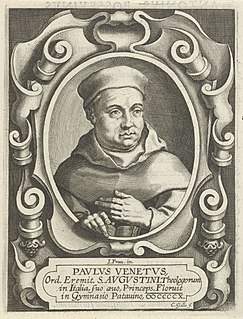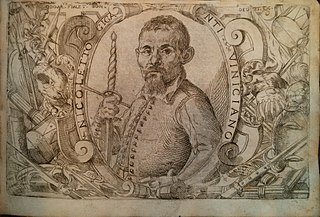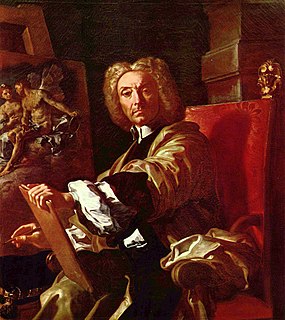Paolo da Pergola [1] (died 1455, Venice) was an Italian humanist philosopher, mathematician and Occamist [2] logician. He was a pupil of Paul of Venice. [3]
Paolo da Pergola's most important work was probably De sensu composito et diviso. [4] His logical works were printed early. [5]
He taught at the Scuola di Rialto from 1421 to 1454. [6] He was teacher and friend of the glassmaker Antonio Barovier. [7]
Among his pupils was also Nicoletto Vernia, a well known professor of philosophy in Padua. [8]
There is a memorial to him in San Giovanni Elemosinario, Venice. [9]

Giovanni BattistaPiranesi was an Italian Classical archaeologist, architect, and artist, famous for his etchings of Rome and of fictitious and atmospheric "prisons". He was the father of Francesco Piranesi and Laura Piranesi.

Giovanni Bellini was an Italian Renaissance painter, probably the best known of the Bellini family of Venetian painters. His father was Jacopo Bellini, his brother was Gentile Bellini, and his brother-in-law was Andrea Mantegna. He was considered to have revolutionized Venetian painting, moving it towards a more sensuous and colouristic style. Through the use of clear, slow-drying oil paints, Giovanni created deep, rich tints and detailed shadings. His sumptuous coloring and fluent, atmospheric landscapes had a great effect on the Venetian painting school, especially on his pupils Giorgione and Titian.

The Basilica di Santi Giovanni e Paolo, known in Venetian as San Zanipolo, is a church in the Castello sestiere of Venice, Italy.

The Gallerie dell'Accademia is a museum gallery of pre-19th-century art in Venice, northern Italy. It is housed in the Scuola della Carità on the south bank of the Grand Canal, within the sestiere of Dorsoduro. It was originally the gallery of the Accademia di Belle Arti di Venezia, the art academy of Venice, from which it became independent in 1879, and for which the Ponte dell'Accademia and the Accademia boat landing station for the vaporetto water bus are named. The two institutions remained in the same building until 2004, when the art school moved to the Ospedale degli Incurabili.
GiacomoZabarella was an Italian Aristotelian philosopher and logician.

Paul of Venice was a Catholic philosopher, theologian, logician and metaphysician of the Order of Saint Augustine.

Pordenone, Il Pordenone in Italian, is the byname of Giovanni Antonio de’ Sacchis, an Italian Mannerist painter, loosely of the Venetian school. Vasari, his main biographer, wrongly identifies him as Giovanni Antonio Licinio. He painted in several cities in northern Italy "with speed, vigor, and deliberate coarseness of expression and execution—intended to shock".

Nicoletto Giganti was a 17th-century Italian rapier fencing master. The frontispiece of his 1606 work names him as “Nicoletto Giganti, Venetian”, although evidence suggests he or his family, moved to Venice from the town of Fossombrone, in Le Marche, Central Italy.

Francesco Solimena was a prolific Italian painter of the Baroque era, one of an established family of painters and draughtsmen.

The Italian Catholic Diocese of Adria-Rovigo, in the Triveneto, has existed under this name since 1986. It is a Latin suffragan to the Patriarchate of Venice.

Giovanni Antonio Fasolo (1530–1572) was a late Renaissance Italian painter of the Venetian school, active in Vicenza and surroundings.
In the history of logic, the term logica nova refers to a subdivision of the logical tradition of Western Europe, as it existed around the middle of the twelfth century. According to the availability at the time of the logical works of Aristotle in Latin translation, there was a logica vetus and the logica nova.

Santi Prunati was an Italian painter of the Baroque era, born and mainly active in Verona.

Leonardo Corona (1561–1605) was an Italian painter of the Renaissance period, active mainly in Venice. Born in Murano. For the church of Santi Giovanni e Paolo in Venice, he painted an Annunciation; while for Santo Stefano, he painted an Assumption. For San Giovanni in Bragora he painted a Coronation with Thorns and a Flagellation. He is said to have been a pupil of the elder Titian, and completed some of his canvases after the master's death. His pupils included Santo Peranda and Baldasarre Anna.

Francesco Rizzo da Santacroce, also known as simply Francesco da Santacroce or Francesco di Bernardo de' Vecchi Da Santa Croce was an Italian painter of the Renaissance period, active mainly in Bergamo and Venice.
Nicoletto Vernia was an Italian Averroist philosopher, at the University of Padua.
Gaetano da Thiene (1387–1465) was an Italian Renaissance philosopher and physician who was born and lived in Padua.
Gabriele Capodilista, also di Capo di Lista, de Capitibus Lista or de Capolista, was an Paduan nobleman, canon lawyer and humanist. He held administrative positions in Perugia (1473–1475) and Rome. He is most famous today for the account he wrote in Italian of his 1458 pilgrimage to the Holy Land, the Itinerario in Terra Santa.